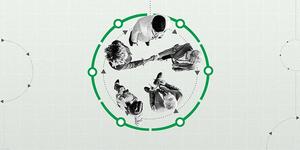Story Highlights
- COVID-19 complicates predictions of customer behavior
- Better forecasting improves reopening, staffing and inventory decisions
Two questions hang over the business world:
- "When will customers feel safe to return?"
- "Will they reach for their wallets when they do?"
It's a very tough call. Consumer attitudes and the impact of the coronavirus vary from country to country, state to state, city to city, and even county to county. And there's no word yet on an ETA for a vaccine, an effective treatment or herd immunity.
Meanwhile, the pandemic left many Americans in worse financial health almost overnight. Gallup data show that Americans are experiencing layoffs (10%), job loss (2%), a reduction in hours (14%), or a loss in income (24%) since mid-March. Further, 29% report worrying about money in the last seven days.
Given these numbers, you might think most -- if not all -- customers would report dismal financial wellbeing.
But they don't.
In May 2020, as unemployment reached its highest level since the Great Depression, Gallup saw a rise in the percentage of people who are "thriving" in their wellbeing -- people who have positive views of their present life situation and have positive views of where they will be in five years.
This increase in the thriving rate implies that, for some, this period of time allowed them to increase their financial wellbeing (one of the five elements of wellbeing) in spite of the complex hardships that have accompanied the pandemic for most.
These economic indicators are confusing, to say the least. And taken at face value, the data could lead to business predictions that are both logical and profoundly wrong.
So using our nationally represented panel and 80,000+ responses to survey questions, Gallup data scientists took a deep dive to make sense of these contradictory economic indicators as well as the changing attitudes and future behaviors related to social distancing and sentiment regarding COVID-19.
Based on the analysis, a new customer segmentation model has emerged that can guide, modify and update decisions made about reopening strategies in addition to adjusting plans based on the ebb and flow of the coronavirus.
Termed "Walking Around With Money" (WAWM), this construct measures groups of consumers who are both:
- Walking Around: defined as those who are willing to be "out and about" in public spaces
- With Money: defined as their ability and propensity to spend money
6 Customer Segments You Need to Know
On a national level, we've segmented Americans into six distinct WAWM groups. And this is what our data show:
- Middle Ground (24%): These Americans are sitting on the fence. They have some concern about COVID-19, but not enough to make them excessively cautious. They are also on neutral territory economically -- not great, but not currently suffering.
- Cautious and Able (24%): These Americans are concerned about COVID-19 and it is altering their daily activities. They're taking more precautions and unlikely to interact with the economy in the same way as they did before COVID-19 -- but they are financially able to do so. These are the folks who are in good shape but opting to stay put.
- Cautious Possibilities (19%): Similarly expressing COVID-19 concerns, these Americans are less economically able -- though not economically suffering -- to spend in the same way as those in the cautious and able group. They're not quite ready to get out of self-isolation but their economic readiness is average.
- Ready and Able (14%): These Americans are ready to go. They express fewer COVID-19 concerns and are making few if any adjustments to their routine to avoid potential exposure. They are also in a strong economic position, making them the most likely to be walking around with money today.
- Cautious, Not Able (10%): This group represents those with COVID-19 concerns and life adjustments and who are also facing economic struggles. They are less likely to be comfortable with engaging in pre-COVID-19 activities and less able to spend money. They are somewhat less ready to be out of self-isolation and are suffering financially.
- Ready, Not Able (9%): Although these Americans express few concerns or adjustments for COVID-19 and they're eager to get out of self-isolation, they are not positioned to spend. They have experienced some economic hardship. They're left feeling ready to return to life as normal, but as consumers, they're economically unable.
Using COVID-19 cases, death counts, 12 weeks of trended Gallup Panel data, and small-area estimation, the WAWM segmentation dataset is able to understand customers' "willingness to be out in public spaces and spending money" down to a county level across the U.S. We can forecast these results six weeks into the future and provide weekly updates on the density of each cluster over time as Gallup continues to collect these data and update the dataset weekly.
Consumer Behaviors in a Novel Historical Moment
Right now, the ability to forecast is a superpower for business leaders as consumer sentiments and behaviors change. Some of these changes are likely permanent but many changes are temporary.
Temporary and highly localized. Knowing which changes will last and which changes will be short-lived is crucial to meeting the market segment that's walking around with money -- and preparing for the segment that's waiting.
What do your customers experience?
- Find out with Gallup analytics. We help companies worldwide engage their customers.
- Predict customer behavior in volatile times. Register for a webinar to learn about our new forecasting model.
- Build customer centricity into your culture. Read "Gallup's Approach to Culture: Building a Culture That Drives Performance.





